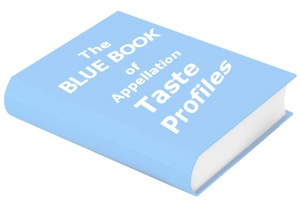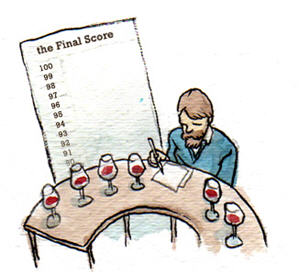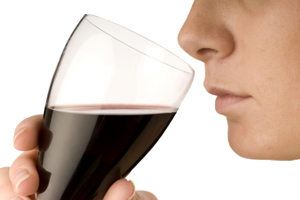

Critiquing the Critics:
The Wine Judging Revolution
Changing the way wine is evaluated, APPELLATION AMERICA is on the job.
by
Clark Smith
February 9, 2009
 merican wine judging has problems. The practice of “blind” tasting, in which judges are deprived of all information about a wine except its varietal (and sometimes its vintage), creates an information vacuum in which any diversity or distinctiveness of character appears as a flaw. Coupled with the infamous 100-point scoring or some other criteria-free, linear rating scheme, blind tasting by varietal has hit the wall. Current tasting methodology ends up telling us nothing about whether the wine is doing its job.
merican wine judging has problems. The practice of “blind” tasting, in which judges are deprived of all information about a wine except its varietal (and sometimes its vintage), creates an information vacuum in which any diversity or distinctiveness of character appears as a flaw. Coupled with the infamous 100-point scoring or some other criteria-free, linear rating scheme, blind tasting by varietal has hit the wall. Current tasting methodology ends up telling us nothing about whether the wine is doing its job.
What job is that, you ask? Any European would answer that a wine’s job is to represent its place of origin. Medals only tell us that a wine is a typical example of a varietal, whatever that may mean. Such awards do little to guide the consumer. Worse, they fall short of connecting us to the rich adventure of regional character. No one would dream of tasting Chinon, Graves and St. Emilion blindly under a Cabernet Franc category.
There is really nothing wrong with rating, but it requires a context. Rating systems succeed in Europe because the appellations narrowly define products of origin, be they Roquefort, Parma ham, or Port, through legal restrictions on what can be grown, made and sold. It is not difficult to judge, say, Reserva Chianti or Nouveau Beaujolais because

Most U.S. and Canadian wines today, failing to fit into some narrow and vaguely defined mainstream expectation, are relegated to sub-90-point “loser” status, damned for nonconformity rather than celebrated for their uniqueness. It’s worse than what we all went through in high school.
We used to fool ourselves that we could do the same thing in California (we never even thought in terms of America) through simple varietal categories, a labeling approach first pushed by Frank Schoonmaker, then adopted by Gallo, and later pushed by U.C. Davis. In 1975, there were less than a hundred wineries and barely a thousand products on the market. Also, quality was generally poor, so you could break the market into a few popular varietal categories, throw out the spoiled wines, rate a handful of, say, top Cabernets, and be done.
This isn’t working anymore. With thousands of Cabernets and Chardonnays on the market, we simply need more distinctions. A recent study by Prof. Robert Hodgson of Humbolt State, commissioned by the California State Fair Wine Competition, shows that judges in varietal-based competitions are inherently much more consistent about what they dislike than concerning what they do like. There’s just too damn much good wine out there, so competitions are a total crap shoot.
A well organized, knowledgeable third party validation is needed to initiate the process of mapping out appellation wine identities in order to organize consumer expectation in America as it already exists in Europe. APPELLATION AMERICA has undertaken the challenge of leading this process.
Time for Change
As a winemaking innovator, I devoted fifteen years at Vinovation to transforming how wine is made and to offering solutions to quality challenges such as excessive alcohol, tannin structure, sulfite-free winemaking methods, cold stabilization alternatives, and so forth. But in early 2008, I came to realize that I was needed elsewhere. Winemaking challenges were no longer the industry’s most pressing problems. An increasingly dysfunctional evaluation system had begun to stymie growth and creativity, and making wine, especially offbeat wines of distinctive expression, was in danger of becoming no fun.I realized that there was now too much good wine out there for the existing market to sort through. The three-tier system was designed to handle perhaps a
 thousand domestic wines in a time when defects were common and regional styles hadn’t gelled. But now APPELLATIONAMERICA.COM lists over 25,000 wines throughout North America, a diversity which is impossible to appreciate or fairly judge when thrown into massive gangs - hundreds of Chardonnays and Cabernets, blindly tasted without regional information. Yet this is the standard practice.
thousand domestic wines in a time when defects were common and regional styles hadn’t gelled. But now APPELLATIONAMERICA.COM lists over 25,000 wines throughout North America, a diversity which is impossible to appreciate or fairly judge when thrown into massive gangs - hundreds of Chardonnays and Cabernets, blindly tasted without regional information. Yet this is the standard practice.
So last summer, I licensed out my wine production service business and turned my full attention to the huge challenge of revamping American wine tasting from the ground up, hiring on at APPELLATION AMERICA. The solution we set up is the Best-of-Appellation™ Evaluation Program.
The BOA Program [see sidebar] works in an opposite manner to conventional tasting. Its main thrust is to identify threads of commonality within an AVA and to pinpoint terroir-based signatures as they currently exist and as they develop over time. Wines which exemplify the region they come from are awarded Best-of-Appellation status and tasting notes are permanently featured on our site.
Parsing The Sublime – American Style
The well-organized European appellation system confers a tremendous competitive advantage, because the consumer knows exactly what a Mosel Kabinett or a Muscadet is supposed to be. Rigid central planning gives the consumer knowledgeable access to half a million wines. It’s the law. The resulting regional identity not only offers consumers a lifetime of enjoyable exploration, but also provides a style guide to purchase, based on personal preference, age-worthiness, and pairing with food.In the free market economy for which Americans are known, things will never be so simple. Not only is any winery permitted to grow whatever varieties they choose, but they are also permitted to vinify in a wide variety of styles, resulting in dizzying complexity for the consumer. Yet, with the help of technology, it is now manageable.
About The Best-Of-Appellation™ Evaluation Program
The Best-of-Appellation™ Process is centered on structured tastings designed to distill the specific wine characteristics associated with the natural and cultural traditions of each region. Wines that are determined by the BOA Panel to best express the characteristics of their appellation earn APPELLATION AMERICA’s Best Of Appellation™ awards.
OBJECTIVE
The BOA Program seeks to crystallize and promote memorable images of North America's numerous appellations in order to expand the market for North American wines and enrich the global wine culture.
FIRST PRINCIPLES
The place defines the wines; the wines define the place. To a very large extent, wine character reflects its place of origin. Local soil and climate, quirks of history and market influences all leave their stamp. Pa
 READER FEEDBACK: To post your comments on this story,
click here
READER FEEDBACK: To post your comments on this story,
click here
Print this article | Email this article | More about America | More from Clark Smith














